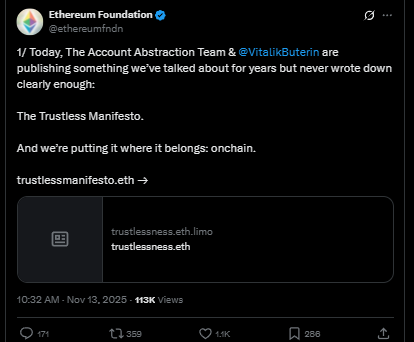- Vitalik Buterin and the Ethereum Basis launched the Trustless Manifesto to re-emphasize decentralization, neutrality, and censorship resistance.
- The manifesto warns builders in opposition to shortcuts like hosted nodes or centralized relayers, which steadily weaken Ethereum’s trustless design.
- EF additionally shut down the Holešky testnet after upgrades like PeerDAS and Pectra made it pointless transferring ahead.
The Ethereum Basis, alongside Vitalik Buterin, simply rolled out one thing that seems like a return-to-roots second for all the ecosystem: the Trustless Manifesto. It’s mainly a reminder — or possibly a warning — that Ethereum’s core values shouldn’t get misplaced within the rush for comfort. The message is loud however not precisely new: decentralization, censorship resistance, neutrality, and self-custody aren’t optionally available add-ons… they are Ethereum. And the muse appears decided to place these ideas again entrance and heart.

The Imaginative and prescient Behind the Trustless Manifesto
The manifesto was co-authored by Vitalik Buterin and EF researchers Yoav Weiss and Marissa Posner. They admitted that this wasn’t some sudden thought — the dialog had been floating round for years with out anybody really placing it into movement. Now, although, the workforce says they’re lastly “placing it the place it belongs: onchain,” which feels symbolic in all the fitting methods.
At its core, the Trustless Manifesto pushes builders to keep away from shortcuts that slowly centralize the community. Hosted nodes, centralized relayers, convenience-driven checkpoints — all of the little issues that appear innocent at first — ultimately chip away at Ethereum’s permissionless nature. In line with the EF, each single “fast repair” provides friction to decentralization, and over time these tiny compromises can flip into choke factors. The manifesto explicitly defends values like credible neutrality, verifiability, and agency resistance to what it calls “handy centralization.”
One line from the authors hits particularly onerous: “Trustlessness is just not a function so as to add after the actual fact. It’s the factor itself.” And truthfully, that’s the sort of reminder Ethereum’s ecosystem in all probability wanted proper now.
Why This Issues for Builders
The manifesto is mainly telling builders: don’t sacrifice Ethereum’s basis for sooner development or simpler onboarding. If one thing requires a trusted middleman, a dependency on a centralized service, or a checkpoint that decides what’s “legitimate,” then it’s in all probability steering the community off-course.
Vitalik and the EF warn that rising complexity — particularly in rollup infrastructure — usually tempts builders towards centralization. It’s sooner, it’s cleaner, it avoids complications. However it additionally creates single factors of failure that go in opposition to every little thing Ethereum stands for. The doc encourages devs to remain intentional, preserve issues verifiable, and protect the protocol’s neutrality, even when meaning slower adoption at first.
EF Shuts Down Holešky Testnet After Current Upgrades
This manifesto drop comes because the Ethereum Basis continues adjusting its technical roadmap. Simply weeks earlier, the EF formally shut down the Holešky testnet — a large testing surroundings launched in 2023. Holešky performed an necessary position in validating options for the Pectra improve (accomplished in Might 2025), however it will definitely bumped into points: validator inactivity leaks, lengthy exit queues, and operational friction that made it robust to take care of.
For the reason that Fusaka improve testing wrapped up (introducing PeerDAS, which cuts validator bandwidth necessities and boosts L2 scalability), Holešky’s position was mainly fulfilled. The EF determined it was time to sundown it and transfer on with extra environment friendly testing infrastructure.
Disclaimer: BlockNews offers unbiased reporting on crypto, blockchain, and digital finance. All content material is for informational functions solely and doesn’t represent monetary recommendation. Readers ought to do their very own analysis earlier than making funding selections. Some articles could use AI instruments to help in drafting, however every bit is reviewed and edited by our editorial workforce of skilled crypto writers and analysts earlier than publication.